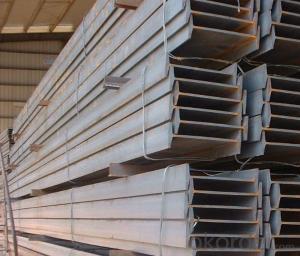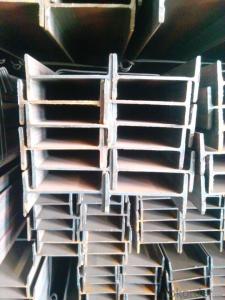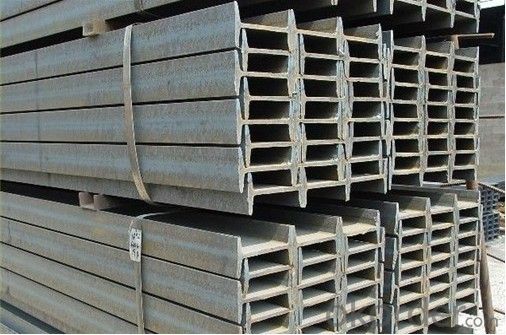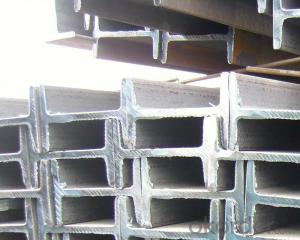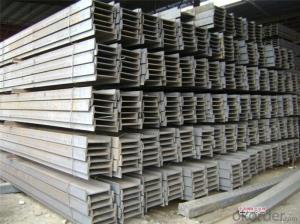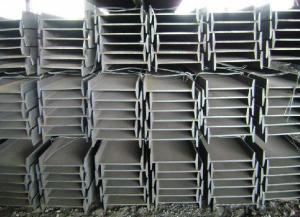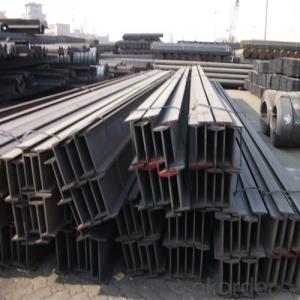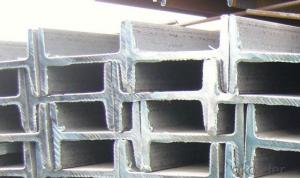Hot Rolled IPE and IPEAA Beams Grade Q235 Steel I-Beams
- Loading Port:
- Tianjin
- Payment Terms:
- TT or LC
- Min Order Qty:
- 25 m.t.
- Supply Capability:
- 10000 m.t./month
OKorder Service Pledge
OKorder Financial Service
You Might Also Like
OKorder is offering high quality Hot Rolled Steel I-Beams at great prices with worldwide shipping. Our supplier is a world-class manufacturer of steel, with our products utilized the world over. OKorder annually supplies products to European, North American and Asian markets. We provide quotations within 24 hours of receiving an inquiry and guarantee competitive prices.
Product Applications:
Hot Rolled Steel I-Beams are ideal for structural applications and are widely used in the construction of buildings and bridges, and the manufacturing, petrochemical, and transportation industries.
Product Advantages:
OKorder's Steel I-Beams are durable, strong, and resist corrosion.
Main Product Features:
· Premium quality
· Prompt delivery & seaworthy packing (30 days after receiving deposit)
· Corrosion resistance
· Can be recycled and reused
· Mill test certification
· Professional Service
· Competitive pricing
Product Specifications:
Manufacture: Hot rolled
Grade: Q195 – 235
Certificates: ISO, SGS, BV, CIQ
Length: 6m – 12m, as per customer request
Packaging: Export packing, nude packing, bundled
Chinese Standard (H*W*T) | Weight (Kg/m) | 6m (pcs/ton) | Light I (H*W*T) | Weight (Kg/m) | 6m (pcs/ton) | Light II (H*W*T) | Weight (Kg/m) | 6M |
100*68*4.5 | 11.261 | 14.8 | 100*66*4.3 | 10.13 | 16.4 | 100*64*4 | 8.45 | 19.7 |
120*74*5.0 | 13.987 | 11.9 | 120*72*4.8 | 12.59 | 13.2 | 120*70*4.5 | 10.49 | 15.8 |
140*80*5.5 | 16.89 | 9.8 | 140*78*5.3 | 15.2 | 10.9 | 140*76*5 | 12.67 | 13.1 |
160*88*6 | 20.513 | 8.1 | 160*86*5.8 | 18.46 | 9 | 160*84*5.5 | 15.38 | 10.8 |
180*94*6.5 | 24.143 | 6.9 | 180*92*6.3 | 21.73 | 7.6 | 180*90*6 | 18.11 | 9.2 |
200*100*7 | 27.929 | 5.9 | 200*98*6.8 | 25.14 | 6.6 | 200*96*6.5 | 20.95 | 7.9 |
220*110*7.5 | 33.07 | 5 | 220*108*7.3 | 29.76 | 5.6 | 220*106*7 | 24.8 | 6.7 |
250*116*8 | 38.105 | 4.3 | 250*114*7.8 | 34.29 | 4.8 | 250*112*7.5 | 28.58 | 5.8 |
280*122*8.5 | 43.492 | 3.8 | 280*120*8.2 | 39.14 | 4.2 | 280*120*8 | 36.97 | 4.5 |
300*126*9 | 48.084 | 3.4 | 300*124*9.2 | 43.28 | 3.8 | 300*124*8.5 | 40.87 | 4 |
320*130*9.5 | 52.717 | 3.1 | 320*127*9.2 | 48.5 | 3.4 | |||
360*136*10 | 60.037 | 2.7 | 360*132*9.5 | 55.23 | 3 |
FAQ:
Q1: Why buy Materials & Equipment from OKorder.com?
A1: All products offered byOKorder.com are carefully selected from China's most reliable manufacturing enterprises. Through its ISO certifications, OKorder.com adheres to the highest standards and a commitment to supply chain safety and customer satisfaction.
Q2: How do we guarantee the quality of our products?
A2: We have established an advanced quality management system which conducts strict quality tests at every step, from raw materials to the final product. At the same time, we provide extensive follow-up service assurances as required.
Q3: How soon we can delivery the goods ?
A3: We have a mill with 20000mts of capacity per month. We can delivery the goods within in one month ,as long as your order quantity less than 20000mts .
Images:
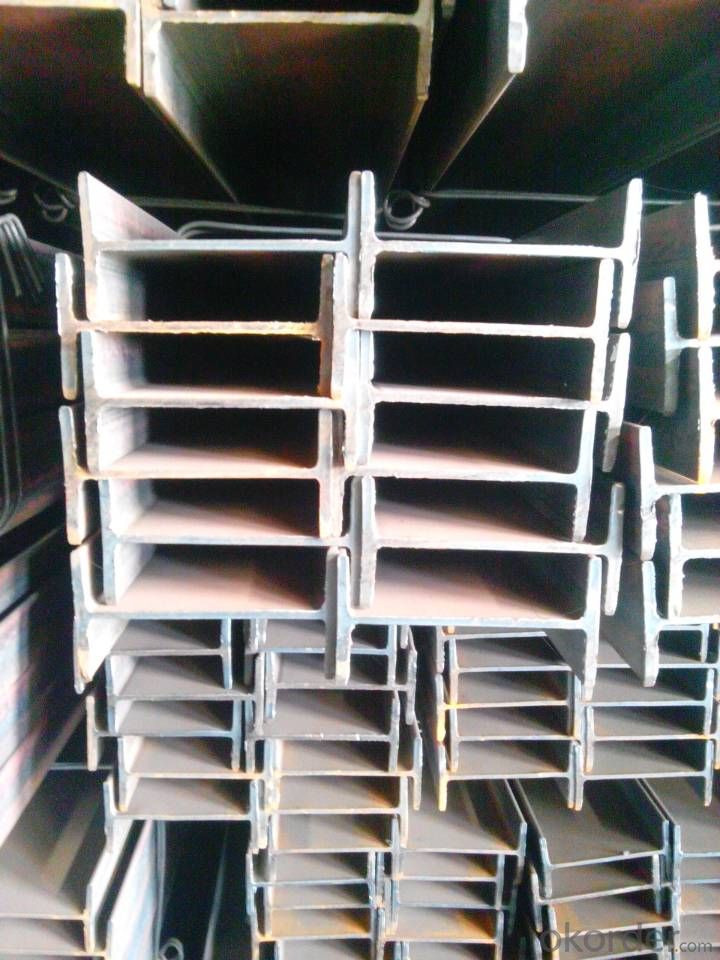

- Q: What's the minimum specification for I-beam?
- The minimum specification for I-beam is 10#.I-beam is also called steel girder (English name Universal)(Beam) a strip of steel with an I-shaped section. I-beam is made of ordinary I-beam and light i-beam. It is a section steel whose shape is trough.
- Q: Do Steel I-Beams require special handling during installation?
- Yes, Steel I-Beams do require special handling during installation. They are heavy and cumbersome, so proper lifting equipment and techniques are essential to ensure safe and precise placement. Additionally, careful attention must be given to their structural integrity and alignment to prevent any potential damage or compromise to the overall stability of the structure.
- Q: Are there any building codes or regulations that govern the use of steel I-beams in construction?
- Yes, there are building codes and regulations that govern the use of steel I-beams in construction. These codes and regulations are put in place to ensure the structural integrity and safety of buildings. The specific codes and regulations may vary depending on the country or region, but they generally cover aspects such as the design, fabrication, installation, and inspection of steel I-beams. In the United States, for example, the use of steel I-beams is regulated by the International Building Code (IBC). The IBC provides guidelines for the design and construction of buildings, including the use of structural steel components like I-beams. It specifies requirements for factors such as the size and shape of the I-beams, the connection details, and the load-bearing capacities. Compliance with the IBC ensures that the steel I-beams used in construction meet the necessary safety standards. Other countries may have their own building codes and regulations that specifically address the use of steel I-beams. For instance, in the United Kingdom, the regulations are outlined in the Building Regulations. These regulations cover various aspects of construction, including the use of steel beams, and provide guidelines for their design, fabrication, and installation. It is essential for architects, engineers, and contractors to familiarize themselves with the applicable building codes and regulations in their respective jurisdictions to ensure compliance with the necessary standards when using steel I-beams in construction. By adhering to these codes and regulations, they can ensure the structural integrity and safety of buildings, as well as meet the legal requirements for construction projects.
- Q: How do steel I-beams perform in high humidity environments?
- The strength and durability of steel I-beams are widely recognized, and they exhibit excellent performance in high humidity conditions. Nevertheless, extended exposure to high humidity can potentially impact steel I-beams in various ways. One of the main concerns in high humidity settings is the potential for corrosion. When steel comes into contact with moisture, particularly in the presence of oxygen, it can undergo a chemical reaction and produce rust, which weakens its structural strength. The risk of corrosion may be elevated in areas with consistently high humidity. To counteract the effects of humidity on steel I-beams, several measures can be implemented. Firstly, the steel can be coated with protective coatings such as paint or galvanization. These coatings serve as a barrier against moisture and help prevent corrosion. Regular inspection and maintenance are also crucial for promptly identifying and addressing any signs of corrosion before they worsen. In addition, ensuring proper ventilation and humidity control within the environment can minimize the likelihood of moisture accumulation on the surface of steel I-beams. By maintaining relative humidity levels within recommended ranges, the risk of corrosion can be significantly reduced. In conclusion, while steel I-beams are generally dependable in high humidity environments, it is vital to employ protective measures and maintenance practices to ensure their long-term performance and structural integrity.
- Q: Can steel I-beams be used in religious or worship facilities?
- Yes, steel I-beams can be used in religious or worship facilities. Steel I-beams are commonly used in construction due to their strength and durability. Their structural integrity makes them suitable for supporting large roofs or spanning wide distances, which can be advantageous in religious or worship facilities that often have high ceilings or open spaces. Additionally, the use of steel I-beams allows for flexible and creative architectural designs, accommodating various styles and preferences in religious buildings.
- Q: What does "No. ten I-beam" mean? How is the number of I-beam divided?
- No. ten I-beam refers to the cross section height of 100 mm. That is 10 centimeters.
- Q: I-beam shelf - shelf materials from what can be roughly divided into?
- The shelf from the material, can be divided into the following categories: 1, steel shelf: it is currently on the market sales of the larger varieties, from the warehouse to the supermarket shelves, iron and steel, large volume, the reason should be the excellent mechanical properties of steel processing and good weldability can (for example); 2, wooden shelves, mostly used for home storage or supermarket display; 3, aluminum shelf: because of its portability and aesthetics, is mostly used in supermarket, the carrying capacity is limited;
- Q: How do steel I-beams contribute to the overall stability of a building?
- Steel I-beams contribute to the overall stability of a building by providing structural support and load-bearing capabilities. Due to their shape and composition, I-beams are able to distribute weight evenly across their length, allowing them to bear heavy loads. They are commonly used in the construction of buildings because of their high strength-to-weight ratio, which makes them capable of withstanding significant forces and minimizing the risk of structural failure. Additionally, I-beams can be connected together to form a framework, creating a rigid and stable structure that can withstand various external forces such as wind, earthquakes, and heavy loads.
- Q: Can steel I-beams be used in shopping malls or commercial buildings?
- Yes, steel I-beams can definitely be used in shopping malls or commercial buildings. In fact, they are commonly used in the construction of such structures due to their strength, durability, and versatility. Steel I-beams have excellent load-bearing capabilities, allowing them to support heavy loads and withstand high levels of stress. This makes them ideal for use in large, open spaces like shopping malls or commercial buildings, where there is a need for wide spans and open floor plans. Additionally, steel I-beams are resistant to fire and other natural elements, making them a safe and reliable choice for structural support in these types of buildings.
- Q: What are the different types of steel coatings used for I-beams?
- There are several different types of steel coatings that are commonly used for I-beams. These coatings are applied to the steel to provide protection against corrosion and enhance the durability and longevity of the beams. One of the most common types of steel coating used for I-beams is hot-dip galvanizing. This involves dipping the beams in a bath of molten zinc, which forms a protective layer on the surface of the steel. Hot-dip galvanizing provides excellent corrosion resistance and is particularly well-suited for outdoor applications or environments with high levels of moisture. Another type of steel coating used for I-beams is epoxy coating. This involves applying a layer of epoxy paint to the surface of the beams. Epoxy coatings provide a strong barrier against corrosion and can be customized to meet specific requirements, such as high chemical resistance or fire resistance. Zinc-rich paint coatings are also commonly used for I-beams. These coatings contain a high concentration of zinc particles, which provide cathodic protection to the steel. The zinc particles act as sacrificial anodes, corroding in place of the steel and extending its lifespan. In addition to these coatings, there are also thermal spray coatings, such as metallizing or flame spraying, which involve applying a layer of molten metal onto the surface of the beams. These coatings provide excellent protection against corrosion and can be tailored to meet specific performance requirements. Overall, the choice of steel coating for I-beams will depend on factors such as the desired level of corrosion resistance, the environmental conditions the beams will be exposed to, and any specific performance requirements. It is important to consult with a professional coating specialist to determine the most suitable coating for a particular application.
Send your message to us
Hot Rolled IPE and IPEAA Beams Grade Q235 Steel I-Beams
- Loading Port:
- Tianjin
- Payment Terms:
- TT or LC
- Min Order Qty:
- 25 m.t.
- Supply Capability:
- 10000 m.t./month
OKorder Service Pledge
OKorder Financial Service
Similar products
Hot products
Hot Searches
Related keywords

